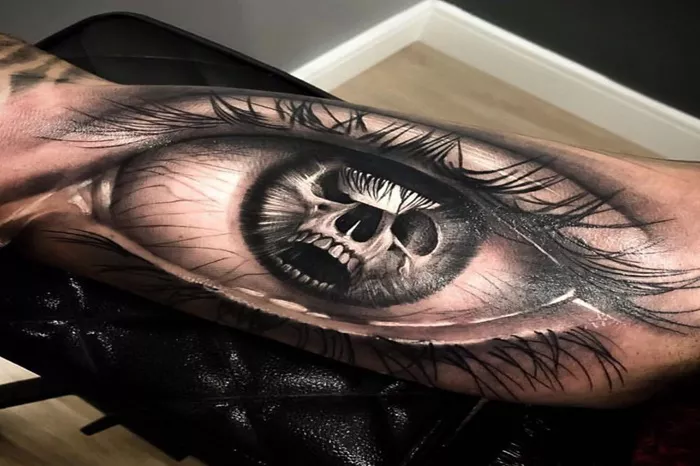Tattoos have long served as a form of self-expression, conveying personal beliefs, experiences, and aspirations. Among the myriad of designs, the eye tattoo stands out as a potent symbol rich in cultural, spiritual, and artistic significance. With its intricate details and mesmerizing gaze, the eye tattoo captivates both the wearer and the observer, invoking curiosity and contemplation. In this comprehensive exploration, we delve into the multifaceted meanings behind eye tattoos, unraveling their symbolism across various cultures and contexts.
The All-Seeing Eye: Symbol of Wisdom and Enlightenment
Central to many interpretations of the eye tattoo is the concept of the “all-seeing eye,” representing wisdom, insight, and enlightenment. Rooted in ancient civilizations such as Egypt and Mesopotamia, the symbol of the eye, often depicted within a triangle or atop a pyramid, was believed to possess divine knowledge and foresight. In contemporary contexts, the all-seeing eye remains a potent emblem, signifying an individual’s quest for knowledge, spiritual growth, and higher consciousness. By adorning the skin with this symbol, tattoo enthusiasts pay homage to the pursuit of enlightenment and the eternal quest for understanding.
The Eye of Protection: Warding Off Evil and Negativity
Across diverse cultures and belief systems, the eye serves as a powerful talisman against malevolent forces and negative energies. Known as the “evil eye” in many traditions, this symbol is thought to possess the ability to deflect harm and safeguard the wearer from misfortune. In Mediterranean cultures, for instance, the “mati” or “nazar” eye is a common motif adorning jewelry, clothing, and even architecture, serving as a constant guardian against jealousy and ill will. Similarly, in ancient folklore and contemporary spiritual practices alike, the eye tattoo serves as a potent amulet, offering protection and repelling negativity with its vigilant gaze.
The Window to the Soul: Expression of Introspection and Self-Awareness
Beyond its symbolic associations, the eye tattoo also serves as a deeply personal expression of introspection and self-awareness. For many individuals, the eyes are regarded as the windows to the soul, reflecting one’s innermost thoughts, emotions, and experiences. By immortalizing this intimate aspect of human anatomy through tattoo artistry, individuals can symbolically convey their journey of self-discovery, introspection, and emotional depth. Whether rendered in hyper-realistic detail or stylized in abstract forms, the eye tattoo invites contemplation and introspection, prompting both the wearer and the viewer to reflect on the complexities of human consciousness and experience.
The Third Eye: Gateway to Spiritual Perception and Inner Vision
In esoteric and spiritual traditions, the concept of the “third eye” holds profound significance as a metaphorical gateway to heightened perception and spiritual insight. Located in the center of the forehead, this mystical eye is believed to transcend physical sight, offering glimpses into realms of higher consciousness and spiritual truth. Through meditation, mindfulness practices, and introspective exploration, individuals seek to awaken their third eye, cultivating inner vision and intuitive wisdom. The third eye tattoo thus serves as a visual representation of this spiritual journey, symbolizing the awakening of consciousness and the pursuit of transcendent truth.
The Eye of Providence: Emblem of Divine Guidance and Providence
Elevated to iconic status in art, architecture, and symbolism, the Eye of Providence is a ubiquitous motif representing divine guidance, protection, and providence. Originating in Christian iconography, where it is often depicted as the eye of God watching over humanity, this symbol has transcended religious boundaries to become a universal emblem of cosmic order and benevolent oversight. Whether emblazoned on currency, emblems of government, or religious artifacts, the Eye of Providence embodies the belief in a higher power guiding and watching over the affairs of mortals. As a tattoo design, it carries with it a sense of divine protection and spiritual assurance, affirming the wearer’s faith in a greater cosmic plan.
The Cyclopean Eye: Symbol of Individuality and Uniqueness
In the realm of fantasy and pop culture, the cyclopean eye emerges as a striking symbol of individuality and uniqueness. Inspired by mythological creatures such as cyclopes and fantastical beings from literature and cinema, the single eye motif represents a departure from conventional aesthetics and a celebration of unconventional beauty. Whether adorned with ornate details or rendered in minimalist simplicity, the cyclopean eye tattoo invites admiration for its boldness and originality. By embracing this symbol, individuals assert their defiance of societal norms and embrace their distinctive identity with pride and confidence.
The Eye of Horus: Legacy of Ancient Wisdom and Protection
In the pantheon of ancient Egyptian mythology, the Eye of Horus occupies a central place as a symbol of protection, healing, and divine sovereignty. Also known as the “udjat” or “Wedjat” eye, this emblem is associated with the falcon-headed god Horus and is believed to possess protective powers against malevolent forces and afflictions. Furthermore, the Eye of Horus is imbued with deep cosmological significance, representing the cycle of life, death, and rebirth. As a tattoo motif, it serves as a homage to ancient wisdom and mystical traditions, invoking the blessings of the gods and affirming the wearer’s connection to timeless spiritual truths.
Conclusion
In conclusion, the eye tattoo transcends mere aesthetic appeal, embodying layers of symbolism, cultural significance, and personal meaning. Whether as a symbol of wisdom, protection, introspection, or spiritual enlightenment, the eye tattoo invites contemplation and interpretation, resonating with individuals on a deeply personal level. As the eyes are said to be windows to the soul, so too does the eye tattoo offer a glimpse into the innermost thoughts, beliefs, and aspirations of the wearer. In its eternal gaze, we find a reflection of humanity’s timeless quest for understanding, connection, and transcendence.

